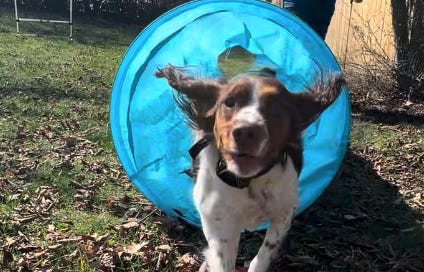Greetings!
I arrive your inbox today with a 3-minute standalone audio piece I produced it for an audio competition, and the process by which I produced it. The competition is complete, and am now able to share it with you!
The piece is about a dog named Toast and her owner, Amy. Toast and Amy’s hobby is dog agility. Things like running through tunnels and hopping over hurdles. I’m not kidding you: I watch dog agility for fun (Here’s my favorite video if you’re interested), so of course I wanted to meet them and see the work in action for a potential episode of Niche to Meet You.
In the sharing of the finished work, I’m going to use this post as an exploration into creativity…a look at my own personal sandpit where I go in the quiet moments that are entirely my own and play around with sound and words and story and philosophy. How I approach a blank canvas, maybe? Sure.
An exercise like this is nearly impossible for a longer piece like what I do for Niche to Meet You, in the same way an artist can’t simply sit down and tell you how they came to write an album. You just take one step at a time until finally you think, “ok, it’s time for me to be done with this.” And you ship it.
But this shorter piece is a little easier to unpack, so unpack I shall!
If you want to get inside my head, read on. If not, I harbor no offense. You are welcome to listen to the piece above and go on your way. And please, enjoy :)
The Process
Setting Course
A couple weeks after the interview with Amy (and Toast—who showed me her skills!) at her home, I began to explore how to craft story, and a path wasn’t making itself clear. That can happen sometimes. It can be disorienting and scary, or you can decide to let it soak and buffer and load in the background while you focus on other things. Eventually, something will materialize. And that’s what happened with Toast’s story.
One day out of nowhere, I learned about AudioFlux. It’s an audio competition that provides a handful of guidelines for each round of competition, with the final product being no more than 3 minutes. The first two rounds (called “Circuits”) were invite-only, but the third—“Pet Sounds”—would be open to public entries. The guidelines for the final 3-minute piece were thus:
Feature a pet protagonist or antagonist
Exhibit a moment of audible ALL CAPS
Reference the color blue
Amazingly, my unedited tape of Toast and Amy included all of those qualifications:
Toast is a dog
I had a couple moments of Toast completing a jump or a tunnel, in which Amy and I both scream “YES!”
Toast’s tunnel is blue
I mean, it was meant to be. And what’s more, the guidelines provided the key to unlocking this story I wanted to tell. Here’s how.
Finding the Story
It all came down to perspective.
To fit the guidelines, I was forced to consider the story from the perspective of the dog as the protagonist…not the owner, Amy. It was a challenge, as most of my work begins with the interview subject as the lead character or hero who goes through evolution and growth (Or maybe it’s not even the person themselves, it’s the understanding of the thing they do. In the case of Niche to Meet You, it’s almost as if the listener is the protagonist, absorbing information and being changed by it. Or maybe that’s my hope?) It was also a challenge because Toast does not speak Human. Ultimately, crafting the story was a creative exercise in looking at something upside-down. Flipping the script.
To start, I wrote an outline from the perspective of a story about Toast. Here are some of my notes as I worked through this:
The story of toast:
Toast as protagonist: the character who drives the action--the character whose fate matters most. THEY CHANGE…make choices, take actions, and are altered. Emotional heart.
Toast:
Choices: To do her job well (job being to support her human)
Actions: Learned new skills…almost like Toast decided this is what they were going to do together. Sensed Amy had an interest, saw an opportunity.
Alteration: Purpose (for her and Amy)
Toast is the protagonist, not Amy. Because Toast is the one who is going through the change to learn new skills and take on the burden of helping her human cope with reality.
The “what”: Amy doing dog agility as a way to cope with reality
The “WHAT”: Toast’s commitment to her human’s wellbeing gives her purpose1
Based on these scribbles, I wrote perspectives of each character as an antagonist. This was stream of consciousness stuff…completely unedited, just threading a needle:
Amy-focused: Once upon a time, little Amy wanted to do dog agility. She had almost forgotten about this dream in adulthood, until her dog, Toast, showed interest in the dogs doing agility on TV. Amy decided to sign them up for classes and they were hooked. Their work together—even if it’s not perfect— helps Amy deal with a stressful work environment, and even gives skills that have taught Amy how cope on a daily basis, outside of dog agility. And the best part? She does all of this with her best, furry friend.
Toast-focused: Once upon a time, there was a dog named Toast. Toast was a happy puppy…especially compared to the others in her litter. Toast was adopted by Matt and Amy, and she began to settle into a dog’s greatest work: supporting the humans she was given. Toast noticed that Amy loved watching dog Agility on TV, and even noticed that Amy would tell Matt about her own childhood dream to do courses herself. Toast thought the sport was interesting too, and saw an opportunity to help her human achieve a dream.
See how each brief synopsis tells a completely different story? I felt a lot like a Pixar writer must…you’re challenged to write a narrative about an inanimate object, or perhaps about something whose personal experience can’t possibly be known, and make them the lead character in the story.
However, you’ve also got to take in to account the other characters’ perspectives and experiences. Woody’s existence relies on Andy’s childhood being experienced, we just don’t see that happening. But we see whispers of it in his birthday party, cowboy camp, misplaced grief/fear showing as exasperation when facing the transition to college—you can’t tell me Toy Story 3 isn’t 100% about Andy and his character growth and fulfillment. But: he probably has less screen time than his mom.
In high school I spent two summers at Speech Camp (this is the first line of my 60 second standup routine I’ve been working on for years)…it’s not a place one goes to learn better speaking habits. It’s worse than that. Its a camp for forensics, a thing in which you compete against others in various public speaking and acting events. And I loved it. Speech Team was one thing I spent many, many hours devoted to. Even ended up in the top 3 of two events my senior year in the state of Illinois.
Anyway - speech camp. I learned about backstory and inner monologues. And how knowing what your character is thinking is crucial to understanding the words your character is saying. So it was important that I wrote a story for my leading lady, Toast, just like I had Amy’s story in words.
Once I had those perspectives, I completed Toast’s story:
Once upon a time, there was a dog named Toast. Toast was a happy puppy…especially compared to the others in her litter. Toast was adopted by Matt and Amy, and she began to settle into a dog’s greatest work: supporting the humans she was given. Toast noticed that Amy loved watching dog Agility on TV, and even noticed that Amy would tell Matt about her own childhood dream to do courses herself. Toast thought the sport was interesting too, and saw an opportunity to help her human achieve a dream.
Toast struggles with agility, but held onto hope that the work she did with Amy would amount to something.
Little did Toast know, this not only helped Amy to work toward accomplishing a dream, but it also helped her cope with a stressful job as a law enforcement officer.
Toast has a lot of learn as an agility athlete…there are still plenty of certificates to earn, more jumps to make, a-frames to perfect…but what she has mastered is perhaps the most important accomplishment of all: to offer her beloved human Amy purpose, which, in so doing…actually gives Toast her own.
There it was. My story. Now all that was left was to find pieces of audio to support it.
Finishing the piece
Once I wrote the narration and added the supporting audio clips to flesh out the skeleton of the thing, the edit was 4 minutes long—1 minute longer than the required length. With my creator beanie affixed to my scalp, I thought it said everything it needed to, and nothing it didn’t. Everything should stay. But when I put on my editor visor, I knew there was more I could cut (this is another speech camp lesson: never be precious about the content…more can always be cut or moved or condensed).
I also phoned a couple friends for listening ears. The value of feedback from knowledgeable and trusted sources early on in the life of a thing cannot be understated. We cannot create in a void. But we also have to be careful. I am fortunate to have several people who are willing to be that “first listen” and take that role seriously. I don’t take them for granted.
The first person I asked for feedback was Chris, who has the same sort of capacity for Niche to Meet You. He is brilliant at reading something and seeing where there’s a hole in logic or theme, or where there are leaps that listeners don’t make. The other friend is Tasha, whose love of Waffle House is far stronger than my own and with whom I’ve shared really meaningful conversation (I also introduced her to Iditarod so now she’s made a friend for life). She’s worked with audio storytelling for twenty years, a lot of that time in radio with strict time restrictions. She’s got a keen ear for the most “important” parts of a story, and what fat should be trimmed. What’s redundant. What adds and what’s just fluff.
For example: I nearly cut the part where I say Amy is a police officer. I wondered if that would cause any tension, or if cultural perceptions would get in the way of the point of that fact. I didn’t mention that to Chris or Tasha, but when asked they both agreed: without that statement, we wouldn’t get the gravitas of Amy’s work stress. It needed specificity. In the same way Carl and Ellie’s story in Up needed the specificity of the miscarriage to drive the emotional heart of Carl’s attachment to the house, which is an extension of Ellie.
Their feedback provided me small tweaks to cut the piece down to 3 minutes and 40 seconds. Forty more seconds needed to go. So I began to consider how I could use narration to move the story along without Amy’s interview—condensing the details into a single sentence instead of a paragraph. Or cutting a little bit of detail that I thought was needed (for example, Amy saying that concerts are stressful. This isn’t necessary for the message).
Finally, it came in under 3 minutes, 10 seconds (which was the allowable range for overage).
The final touch: Sound design. I tend to chip away at this throughout the process…it’s not purely script/audio until the last step. I like putting music under me while I record narration to set a tone. And I like feeling the gratification of a perfect fade in under someone talking, or the timing of a sentence ending just perfectly before the final beat of a song (I am still helplessly a musician, and I find rhythm is totally present in audio editing). If I do this while I work on the final script, I keep myself interested and delighted…and that’s sometimes half the battle, right?
But sound design became particularly important to provide Toast’s voice. This was something Tasha noticed. Of course—I was telling Toast’s story but how to make sure the listener knew there was a dog, when that creature couldn’t respond to a question with a sentence. I listened through my tape again and found moments of panting, or barking, or clicking of nails on hardwood. Then, I overlayed those moments on top of places where Toast is fully present in the narration or interview. I also used a few different takes of a tunnel run to amplify that sound, crescendoing into the ultimate “YES!” Of the piece.
*Magic*
The end result, I think, makes you feel like you’re the one getting booped with the nose of a Brittney Spaniel who loves her people, loves what she does, and just perfectly completed her run through a blue tunnel. I actually grabbed the audio from this video to supplement the final “tunnel run” sequence at the end of the piece:
Shipping it
The very final step before delivery is mastering. There are people way better at this than me. One of those people is Kevin Morris, who does all my mastering for Niche to Meet You. I do the edit and cuts, then bounce each track with volume automation and initial plugins, then he does some fancy stuff with frequencies and panning and it sounds *chef’s kiss*. Completely grateful to Kevin for this final polishing, that I would never be able to accomplish because of how close I am to the working piece.
At that point, I submitted the piece to AudioFlux and crossed my fingers!
Conclusion
When all was said and done, my story about Toast wasn’t selected as a top 7 finalist in the competition, but it was one of 70 submissions and I’m so proud to be included among them.
Toast’s story isn’t done being told…I plan to use the framework of this 3 minute piece to make a longer episode. I’ll keep all the parts I cut to get down to 3 minutes and add in ALL the things I want to use to tell the story with infinite time available.
Special thanks to:
Chris Thiessen
Tasha French Lemley
Kevin Morris
Songs in the piece provided by Blue Dot Sessions:
The what/WHAT exercise is something I learned in a short conversation in 2020 with a pro radio storyteller. I was working on my early idea for the Santa podcast (to be a miniseries this fall…that’s 4 years, if you’re counting), and he said it was interesting but in every story there’s what it’s about, and then by the end there’s a surprise meaning, the REAL purpose for the story…the WHAT. I use this idea a lot.








Share this post